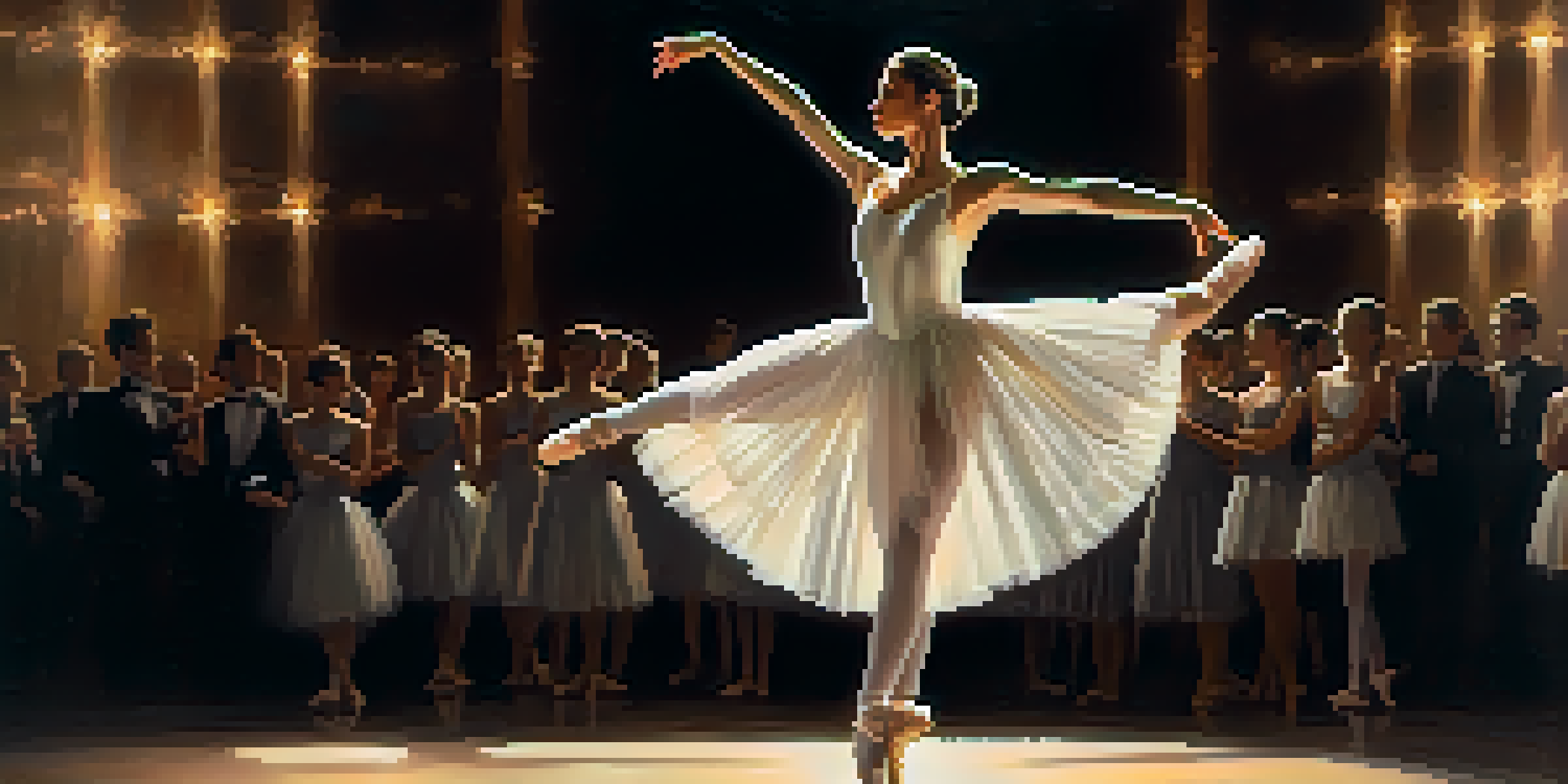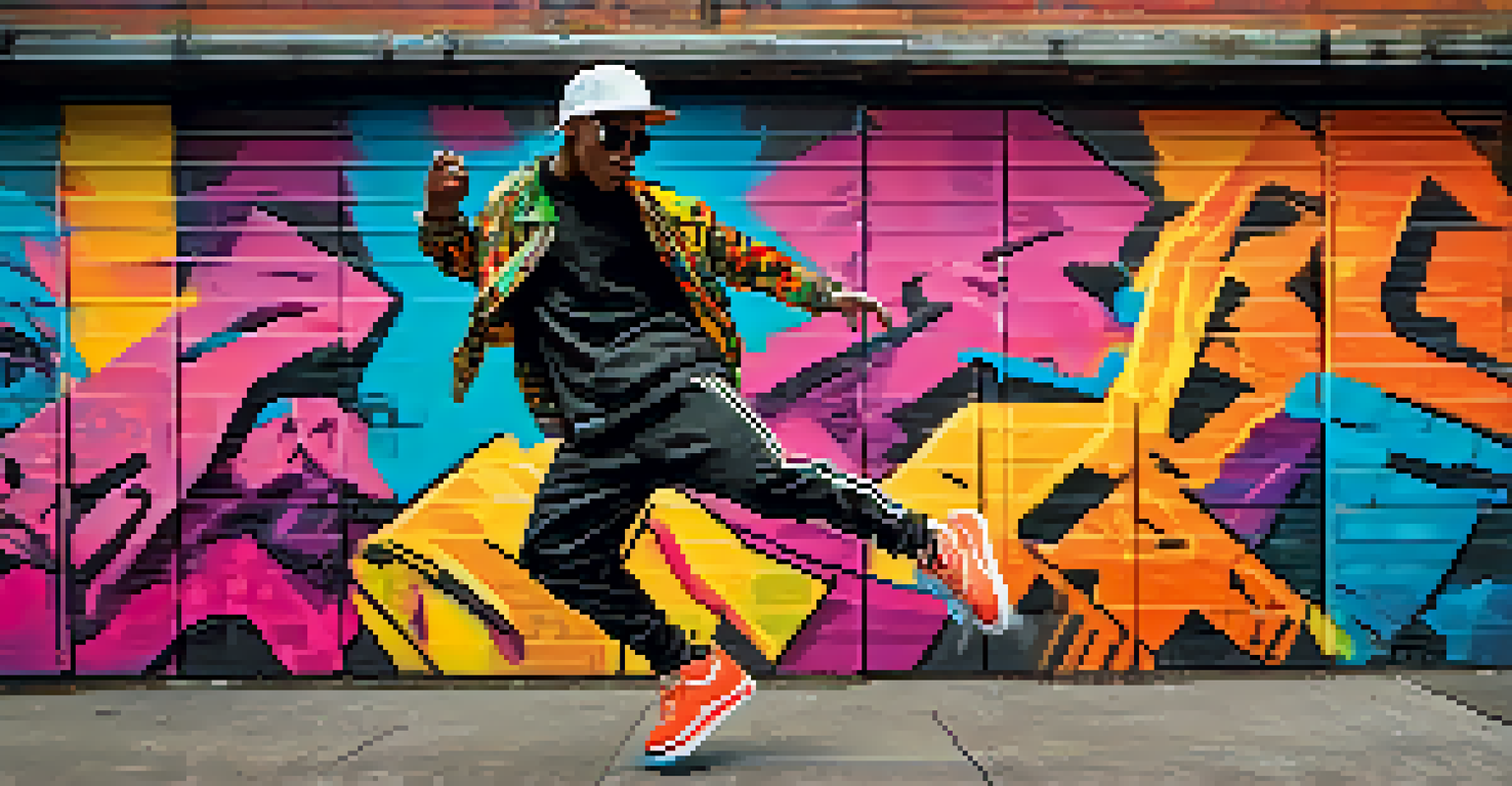How Dance Styles Reflect Different Emotional States and Moods

The Connection Between Dance and Emotion
Dance is a powerful form of expression, serving as a medium to convey emotions. Just as music can evoke feelings, movements in dance also resonate with our emotional states. Whether it's joy, sorrow, or anger, each dance style has its unique way of reflecting what we feel inside.
Dance is the hidden language of the soul.
For instance, consider how a ballet dancer's graceful movements can evoke feelings of serenity and beauty. In contrast, a hip-hop dancer might showcase energy and defiance through sharp, dynamic movements. This connection between dance and emotion helps us communicate what words sometimes cannot.
In essence, dance becomes a universal language, transcending barriers and allowing people to connect through shared feelings. By observing dance, we can gain insight into the emotional landscape of the dancer, making it a rich area for exploration.
Ballet: The Grace of Elation and Sorrow
Ballet is often associated with grace and elegance, but it also beautifully captures a range of emotions. The fluidity of the movements can express joy, as seen in the lively choreography of 'The Nutcracker', where the dancers embody playful elation. Conversely, ballet can depict deep sorrow, such as in 'Swan Lake', where the dancer's emotive expressions tell a tragic story.

The contrast between light and dark in ballet performances allows dancers to explore complex emotional narratives. When a ballerina performs a pirouette with a light touch, it may reflect joy, while a slow, deliberate movement can convey sadness. This range demonstrates how ballet uses physicality to mirror emotional states.
Dance as Universal Emotional Language
Dance transcends barriers, allowing individuals to communicate and connect through shared emotions.
Ultimately, ballet serves as a canvas for a spectrum of feelings, showcasing how this dance form can elicit empathy and connect audiences to the dancer's internal world. It invites viewers to not only watch but also to feel alongside the performers.
Hip-Hop: Energy and Defiance in Motion
Hip-hop dance is synonymous with energy, attitude, and self-expression. Rooted in urban culture, it often reflects themes of empowerment and resilience, making it a powerful outlet for emotions. When dancers hit the floor with bold movements, they convey a sense of defiance and assertiveness that resonates deeply with audiences.
Dance is the joy of movement and the heart of life.
The improvisational nature of hip-hop allows dancers to express their individuality and emotions spontaneously. A sudden pop or lock may reflect a burst of excitement, while slower, grounded movements can signify introspection or struggle. This versatility showcases how hip-hop can capture a wide array of emotional states.
Through its rhythms and beats, hip-hop not only entertains but also tells stories of personal and collective experiences. It serves as a voice for the marginalized, allowing dancers to channel their feelings into powerful performances that engage and inspire.
Contemporary Dance: A Blend of Vulnerability and Strength
Contemporary dance is a melting pot of styles, allowing for a rich exploration of emotions. It often combines elements from various dance forms, resulting in movements that can be both powerful and vulnerable. This adaptability means contemporary dance can effectively express complex emotional states, from elation to despair.
For example, a contemporary performance might begin with fluid, soft movements that evoke tenderness, only to shift into sharp, aggressive actions that illustrate anger or frustration. This ebb and flow of emotions mirrors the unpredictability of human feelings, making it relatable for audiences.
Diverse Styles Reflect Varied Emotions
Each dance style, from ballet to hip-hop, uniquely captures and expresses a wide range of feelings.
The beauty of contemporary dance lies in its ability to blend these contrasting emotions seamlessly. Dancers often use their bodies to communicate narratives that resonate on a personal level, inviting viewers to reflect on their own emotional journeys.
Salsa: Passion and Connection Through Rhythm
Salsa dancing is all about passion, connection, and celebration. The lively rhythm and energetic movements create an atmosphere that resonates with joy and excitement. When dancers step onto the floor, their chemistry and connection can ignite the audience's emotions, making salsa a vibrant expression of shared happiness.
The intricate footwork and playful spins symbolize flirtation and romance, embodying the flirting dance of two partners. Salsa's infectious energy encourages dancers to express their emotions freely, allowing them to connect not only with their partner but also with the audience.
Additionally, salsa can also reflect themes of longing and nostalgia, especially in slower rhythms. This duality showcases how salsa is not just a dance style but a celebration of life and emotions, making it a captivating experience for all involved.
Jazz Dance: The Spirit of Freedom and Joy
Jazz dance is characterized by its upbeat tempos and improvisational style, often reflecting a sense of freedom and joy. The lively movements and syncopated rhythms invite dancers to express themselves in unique ways, allowing for a playful exploration of emotions. When a dancer performs a jazz routine, it’s not just about the steps but also about conveying a genuine sense of happiness.
Jazz also embraces the essence of individuality, encouraging dancers to add their own flair and personality. Each performance becomes a personal expression, where movements can shift from exuberant jumps to smooth, sultry slides, reflecting the dancer's emotional state at that moment.
Dance Invites Personal Connection
Through its expressive movements, dance encourages audiences to see their own emotional experiences reflected in performance.
This ability to adapt and improvise makes jazz dance a dynamic form of expression. It captures the essence of joy and freedom, allowing dancers to share their feelings while inspiring others to embrace their own emotional journeys.
Tap Dance: Rhythm and Emotion in Every Step
Tap dance is unique in that it combines movement with rhythm, making it a powerful form of emotional expression. The sound of the shoes hitting the floor creates a musical dialogue that can convey a wide range of feelings. Whether it’s the quick, sharp taps of excitement or the slower beats of sadness, each sound resonates with the dancer’s emotional state.
The syncopation and improvisation in tap dance allow performers to communicate their emotions in real-time. A lively tap routine can evoke laughter and joy, while a slower, more deliberate performance can express sorrow or contemplation. This versatility showcases the emotional depth that tap dance can provide.

Moreover, the historical roots of tap dance in African American culture add layers of significance to its emotional expressions. As dancers tap away, they tell stories of struggle, resilience, and joy, creating a powerful connection with audiences that transcends words.
Conclusion: The Power of Dance as Emotional Expression
In conclusion, dance serves as a profound language through which we can express our emotions and connect with others. Each dance style offers its unique way of reflecting feelings, whether it’s the elegance of ballet or the energy of hip-hop. By exploring these different styles, we gain insight into the diverse emotional landscapes that dance can convey.
The beauty of dance lies in its ability to resonate with audiences on a personal level, allowing them to see their own experiences reflected in the movements. It encourages us to embrace our emotions, whether they are light and joyful or deep and sorrowful.
Ultimately, dance reminds us of our shared humanity, inviting us to celebrate our feelings and connect with one another through the universal language of movement.